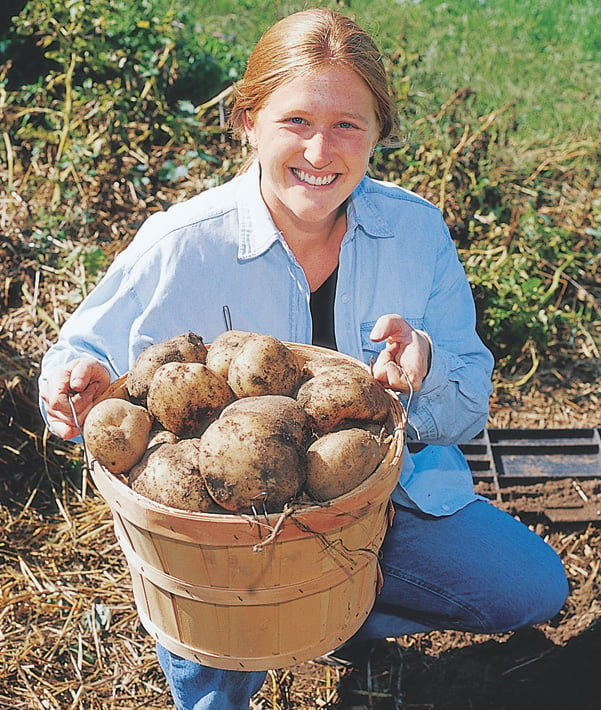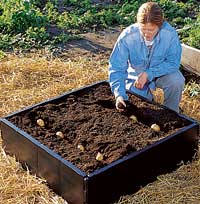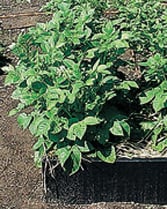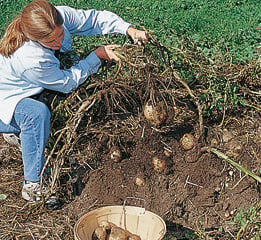Harvest Heaps of Potatoes in Just 9 Square Feet
 Horticultural Technician Sarah Niland shows off a fraction of her potato harvest.
Horticultural Technician Sarah Niland shows off a fraction of her potato harvest.Results from Our Test Garden
It's hard to beat the versatility, delicious flavor and good nutrition of potatoes. Especially when they are organically grown in your own backyard!
The problem is, potatoes tend to take up a lot of space, and hilling and harvesting can be hard, back-straining work. For years, we were looking for an easier way to consistently produce a large harvest of potatoes in a compact, easy-to-manage space.
The solution we found is a space-efficient, raised-bed system using a 3x3 Grow Bed. It's a system we tested and perfected in our trial gardens in Burlington, Vermont. One of our horticultural technicians, Sarah Niland, grew potatoes in these black plastic raised beds, side-by-side with conventional in-ground hills. She treated the plants exactly the same: planted at the same time, watered at the same time, and used the same soil. (If space is an issue, consider the potato grow bag, which only takes up 19".)
What We Discovered
"When it came time to harvest, my co-workers all came out to see the huge potatoes tumble out of the Grow Bed when I unhooked the sides," Sarah said. "We were all amazed at how easy it was, compared to conventional digging."
Sarah found that growing potatoes in a Grow Bed was much easier than growing in the ground and the harvest was bigger! In fact, she harvested 53 pounds of Elba potatoes from just one bed. Overall she averaged 46 pounds of potatoes per bed.
Here's How She Did It:
Planting
Sarah started by loosening the soil underneath the Grow Bed with a garden fork, and then filled the bed with regular garden soil. Two days prior to planting, she cut three seed potatoes into pieces with at least two or three eyes each and allowed them to callous over. She then planted a total of eight pieces per bed, 4-5" deep and 8" apart in two parallel rows (see photo, at right). You only need eight pieces per bed.
 May 11: Planting seed potatoes in the Grow Bed.
May 11: Planting seed potatoes in the Grow Bed.Caring for the Plants
Once the sprouts emerged from the soil and had developed a cluster of leaves about 6" high, she mulched around them with about 2" of straw. She continued adding straw throughout the summer as the plants grew. The straw mulch helped retain moisture, keep the soil cool and suppress weeds.
Potatoes are thirsty plants, so Sarah used drip irrigation. She made sure that the beds received an inch and a half of water per week. In the absence of rain, she irrigated 20 minutes a day, seven days a week, delivering about 1.2 gallons of water per day, per bed.
 June 25: Healthy potato plants are thriving.
June 25: Healthy potato plants are thriving.Harvesting Potatoes
Two weeks prior to harvest, when cooler weather settled in and the plants began to die back, Sarah stopped watering completely. On harvest day, she simply took the bed apart and enormous potatoes tumbled out.
 Sept. 26: Potatotes were easy to harvest; almost no digging required.
Sept. 26: Potatotes were easy to harvest; almost no digging required.
Print this Article:
Get the Dirt
Stay up to date on new articles and advice. Please fill out the information below.
